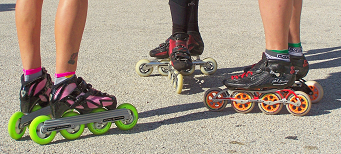Do you recall the first time you stood up on a hard surface with skates on? The pivotal first moment is likely a vivid memory for anybody who immediately started rolling backwards the first time up: that sudden inability to control your feet is a real eye-opener! What happens immediately afterwards is what leads some people to abandon the sport after just one dayís experience. (Skates that donít roll backwards have been invented but unfortunately are not yet in production.)
 The Safe-T is the very first thing I teach every one of my students, both experienced and beginner. Invariably, the instant and tangible result is welcomed with big smiles of appreciation or relief!
The Safe-T is the very first thing I teach every one of my students, both experienced and beginner. Invariably, the instant and tangible result is welcomed with big smiles of appreciation or relief!
During my beginner lessons, the Safe-T becomes a safe-haven and resting pose for my students. This gives us a moment where tension drains from their bodies so they can pay attention to what Iím trying to teach them.
There are many skating situations where competent skaters need to be able to stand still, for example, pausing to chat or waiting to cross an intersection. There is a better way to do this than hugging the stoplight pole or the nearest friendly body!
Assume the position
- Roll the heel of the brakeless boot (for most people, thatís the left) until your back wheel is touching the middle (arch area) of the other skate.Your feet donít have to make a perfect letter T. You can use a smaller angle if that makes you feel more secure.
- Center your weight over both feet. Now you should be able to relax.
- Not relaxed? Then do this test: with knees slightly bent, try to make the skates roll backwards. This will simply wedge them more snugly into the Safe-T.
In the real world
The Safe-T is a handy tool when rising from any awkward spot. Simply keep both hands on the pavement while you arrange your feet in a Safe-T before straightening up. If youíre at a curb or on any kind of incline, make sure to turn your back to the downhill direction before getting up and your skates will automatically lock in place as you arise.
You wonít always need a Safe-T. Once your one-footed balance improves. you will be able to engage the brake by tipping up the braking toe (or scissoring an ABT skate forward). And after a bit more time, you will find yourself unconsciously using exactly the right muscles on a flat spot to keep your skates still without doing much of anything.
